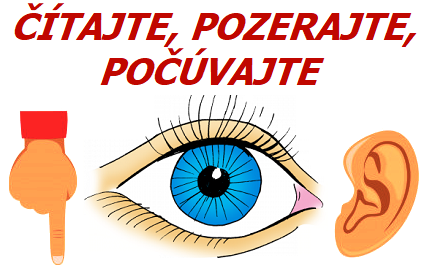17 Stravovanie - FOOD :)
Vytvorené: 18. 10. 2014 Tlačiť
a) Daily food and drink (breakfast, lunch, dinner, supper), favourite dish/food
The first meal of the day is usually breakfast. Breakfast is very important because it gives us energy for the start of the day. The typical breakfast in Slovakia consists of a slice of bread with butter, ham or salami, cheese or jam. Instead of bread we can choose rolls or buns or we can have something sweet like doughnuts or gingerbread. We can also have scrambled eggs and toasts for breakfast. We often drink a cup of tea with honey or sugar and lemon. Some people have for breakfast only a cup of black or white coffee. Those who prefer a healthy breakfast might have yoghurt with fresh fruit or cereals with milk.
Midmorning snack is usually eaten at school or at work. It is good to eat something light and healthy, like fruit or vegetables.
Lunch is between 12 and 2 o´clock. Our lunch is warm and has normally two courses: a soup and a main meal. We can eat vegetable or meat soups. The main meal consists of meat or fish with potatoes or rice and some vegetables. The main dish can be also sweet, for example strawberry or plum dumplings or pancakes with jam and cream. After lunch it is common to drink mineral water, juice, coke or lemonade.
We eat fast food, sandwiches, yoghurts, pudding, fruit as a mid-afternoon snack.
An evening meal can be either warm or cold. Many people eat for dinner what they had for lunch. Some people have only a small snack, like rolls, a cake with milk or tea.
My most favourite meal is chicken with filling and smashed potatoes with vegetable salad.
b) Places where people eat (at school, at home, in a restaurant)
We usually eat our breakfast at home. Most families eat together in the evening and at the weekend. Pupils and students usually bring their snack from home or they buy it in the school buffet. Working people can eat their luch at the restaurant or at a canteen. These canteens mostly offer more meals so that employees can choose what they like. School canteens offer meals for students and teachers at a low price. People go out to eat at the restaurants on special occasions like birthdays or family celebrations. There are waiters who serve us drinks and meals. There are many fast food restaurants too, but they are not very healthy, because they sell junk food.
c) National cuisine – customs, specialities (ingredients, meals, table setting)
Slovak cuisine is unique, but it was influenced by two neighbouring countries – Hungary and Austria. The dishes vary from one region to the next. The Slovak dishes use items such as pork, poultry, cabbage, wheat and potato flour, cheese from cows and sheep, potatoes, onions and garlic.Brynzdové halušky - potato dumplings with sheep cheese and roasted baconis one of the national dishes in Slovakia. Visitors can especially enjoy bryndzové halušky in a typical Slovak restaurant „koliba“ or „salaš“. The best known Slovak soup is kapustnica, a hearty cabbage soup with smoked pork sausage that often contains mushrooms, and sometimes plums, especially at Christmas time. Alcohol is an inseparable part of dining in Slovakia. The specific Slovak distillate is slivovica, a brandy made of plums. Many like to start their dinner with borovička, a juniper berry brandy.
The milk is drunk fresh or sour and all milk products such as whey, cottage cheese, bryndza and sheep cheese are very popular. Smoked or fresh sheep cheese products are sold in different forms and shapes, for example oštiepok or parenica.
d) International cuisine (characteristics, differences, specialities)
Every country has its typical meals and own cuisine. The British like to begin their day with a cup of coffee or tea. They don´t like to hurry when having breakfast. The traditional English breakfast includes cereals, usually cornflakes with milk or porridge. Then they have fried or grilled bacon and eggs, sausages and grilled tomatoes or spicy beans in tomato sauce. To finish the breakfast, they eat buttered toasts and marmalade. Such a big breakfast is usually eaten during the weekend later in the morning and it is called brunch. It involves breakfast and lunch together. Nowadays they prefer a bowl of cereal or a toast and marmalade. At around 10 a.m. the English have elevenses, which is usually a cup of coffee and biscuits. People eat only sandwiches for lunch. The typical British break is 5 o´clock tea. In Britain, tea and coffee are drunk with milk together with some cakes and biscuits. Dinner is an evening meal in Britain. They eat a cooked meal with meat or fish and vegetable salad followed by a dessert. Later in the evening they may have a supper. It consists of more tea, cocoa, milk, sandwiches, bread and butter, cheese, cakes and biscuits. The English are said to boil everything for too long. Typical English meals are fish and chips wrapped in a paper, cheesecake, apple pie, fish pie and butter puding. For Christmas they have a Christmas pudding which is made of candied fruit and always covered with burning brandy.
The Americans prefer oven-ready food and so called „TV-dinners“ what is a complete menu ready for a microwave. They also love doughnuts and of course hamburgers. They drink plenty of coke and eat lots of chips, french fries and pizza.
e) Healthy diet (children’s eating habits, vegetarianism, dieting)
People need to have a well-balanced diet containing roughage, vitamins, minerals and proteins. We should eat mainly fresh vegetables and fruits, milk products, white meat, graham bread and rolls. It is also important to drink at least 2 liters a day – mineral waters, juices without sugar and green or herbal tea. We shouldn´t overeat ourselves and therefore it is better to eat more frequently and in small portions.
Some people don´t eat meat. They are called vegetarians. They eat only vegetables, fruit and eggs. There are more reasons for this eating habit. Some of them like animals and think that it is cruel to kill them and others think that it is healthier not to eat any meat. Vegans don´t eat any animal products at all.
![]()
· Simulácie z fyziky· O Slovensku po slovensky· Slovenské kroje· Kurz národopisu· Diela maliarov· Kontrolné otázky, Domáce úlohy, E-testy - Priemysel· Odborné obrázkové slovníky· Poradňa žiadaného učiteľa· Rýchlokurz Angličtiny. Rozprávky (v mp3)· PREHĽADY (PRIBUDLO, ČO JE NOVÉ?)Seriály:· História sveta (1÷6)· História Slovenska (1÷5)· História módy (1÷5).
Členstvo na portáli
Poznámka pre autora
Copyright © 2013-2026 Wesline, s.r.o. Všetky práva vyhradené. Mapa stránky ako tabuľka | Kurzy | Prehľady |






